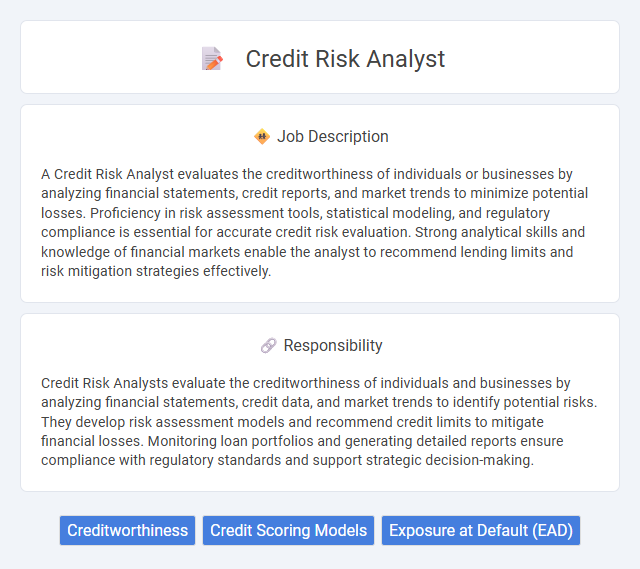
A Credit Risk Analyst evaluates the creditworthiness of individuals or businesses by analyzing financial statements, credit reports, and market trends to minimize potential losses. Proficiency in risk assessment tools, statistical modeling, and regulatory compliance is essential for accurate credit risk evaluation. Strong analytical skills and knowledge of financial markets enable the analyst to recommend lending limits and risk mitigation strategies effectively.
Individuals with strong analytical skills and a keen attention to detail are likely to excel as credit risk analysts, given the job's focus on assessing financial data and predicting borrower reliability. Those comfortable working with complex data sets and making informed decisions under uncertainty may find this role particularly suitable. Conversely, candidates who struggle with quantitative reasoning or financial analysis might face challenges in meeting the demands of the position.
Qualification
A Credit Risk Analyst typically holds a bachelor's degree in finance, economics, or a related field, with proficiency in financial analysis, risk assessment models, and credit scoring techniques. Expertise in statistical software like SAS, R, or Python, along with strong analytical skills and attention to detail, are essential for evaluating borrower creditworthiness and predicting default probabilities. Prior experience in banking, financial institutions, or credit assessment enhances the ability to interpret complex financial data and ensure compliance with regulatory standards.
Responsibility
Credit Risk Analysts evaluate the creditworthiness of individuals and businesses by analyzing financial statements, credit data, and market trends to identify potential risks. They develop risk assessment models and recommend credit limits to mitigate financial losses. Monitoring loan portfolios and generating detailed reports ensure compliance with regulatory standards and support strategic decision-making.
Benefit
A Credit Risk Analyst role likely offers the benefit of developing strong analytical skills by assessing financial data and creditworthiness, which may enhance decision-making abilities. There is a probable opportunity to work closely with cross-functional teams, increasing exposure to different financial sectors and improving professional networking. This position often provides the advantage of contributing to minimizing financial losses, potentially resulting in significant organizational impact and career growth.
Challenge
A Credit Risk Analyst likely faces the challenge of accurately assessing potential loan defaults amid fluctuating economic conditions and incomplete data. They may need to interpret complex financial information and predict borrower behavior under uncertainty. This role probably demands strong analytical skills to balance risk with business objectives effectively.
Career Advancement
Credit Risk Analysts play a crucial role in evaluating financial data to identify potential risks and enhance lending decisions, which directly impacts a company's profitability and risk management strategies. Mastery in advanced data analytics, regulatory knowledge, and risk modeling software significantly increases opportunities for promotion to senior analyst, risk manager, or chief risk officer positions. Continuous professional development through certifications such as FRM (Financial Risk Manager) or CFA (Chartered Financial Analyst) strengthens career growth potential within financial institutions and consulting firms.
Key Terms
Creditworthiness
Credit Risk Analysts specialize in evaluating the creditworthiness of individuals, businesses, or entities by analyzing financial statements, credit reports, and market data to determine the likelihood of default. They utilize quantitative models, risk assessment tools, and economic indicators to forecast potential credit risks and advise on lending decisions. Accurate assessment of creditworthiness is critical to minimizing financial losses and maintaining portfolio quality for banks and financial institutions.
Credit Scoring Models
Credit Risk Analysts utilize credit scoring models to evaluate the likelihood of borrower default by analyzing financial data, credit history, and market trends. These models incorporate statistical techniques such as logistic regression, decision trees, and machine learning algorithms to predict credit risk accurately. Effective use of credit scoring models enables financial institutions to optimize lending decisions, minimize losses, and comply with regulatory requirements.
Exposure at Default (EAD)
Credit Risk Analysts assess Exposure at Default (EAD) to estimate potential losses if a borrower defaults on a loan, using advanced modeling techniques and historical data. EAD quantifies the total value exposed to risk at the moment of default, informing capital allocation and regulatory compliance under frameworks such as Basel II and III. Proficiency in EAD calculation enhances credit risk management by improving predictive accuracy and optimizing portfolio risk strategies.
 kuljobs.com
kuljobs.com